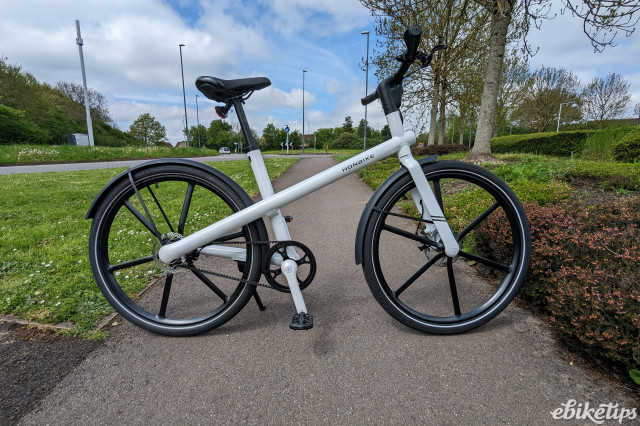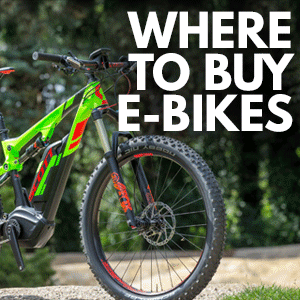Review: MiRiDER One

Overview
- Stable and comfortable for a bike with such a small footprint
- Throttle control
- Larger battery and another gear would be nice
- Finds very steep hills a challenge
At first glance, the MiRiDER One certainly isn’t your typical folding e-bike. It has a fold-in-two magnesium box frame and chunky front and rear forks with rear spring suspension, and magnesium mag-style wheels with a small hub motor in the rear wheel.
Buy the MiRiDER One here
The removable battery is housed in the front half of the folding frame with control electronics in the rear half. There is a small LCD unit next to the left handgrip, from which you can control the five power levels. There is also a trigger throttle next to the right handgrip, and the bike can be used as a pure pedelec just by pedalling forwards, or with the throttle, which overrides the pedelec delivered power; though the pedals must still be turning for the power to be delivered – if it could be operated by throttle alone it would not be a legal e-bike.
Clarks cable-operated disk brakes are specced with 160mm rotors, and there is just a single gear. Handlebars and seatpost are telescopically height-adjustable and the mudguards, kickstand and front light (powered from the main e-bike battery) complete the package.
This is truly a unique mixture of materials, design and components, but it produces a very compact e-bike that folds into an even more compact 67cm x 66cm x 43cm size, and weighs 18.9kg according to my Park Tool scales.
With just a single gear, a modest 187Wh battery, rear suspension and chunky 16 x 1.95” (53-305) tyres, it’s clear the MiRider is aimed firmly at the leisure and short-range commuting market; the kind of e-bike you could pop in the back of a car or on your canal boat and get out for a spin for a few miles... but how does it fulfil this brief?
Performance
My first impressions were that this is a solid frame, and that the neither of the hinges - in the middle of the frame and at the base of the extended handlebar stem - introduce any real appreciable flex; nor do the clamp joints in the telescopic stem and seatpost.
Indeed, for a 16” wheeled bike with a wheelbase shorter than a Brompton it feels remarkably stable and assured, even on fast downhills. I soon learnt to keep my weight back and to apply the cable-operated Clarks disc brakes as gently as possible, as obviously on a bike with these dimensions, there is less room for error than on a full-sized bike. At first the brakes appeared to lack any real modulation, but after a little fettling with the cable outer adjusters and once the pads had bedded in a little, they felt rather more forgiving; although lacking the total control you get with hydraulic disk brakes. Still, I had no worries at all about their stopping power.
The very small cockpit area means a fairly upright riding position, and the bars and seatpost are telescopically adjustable for taller riders. Those with longer limbs will want to check they are comfortable on such a short bike, though.
The motor kicks in pretty quickly once you start pedalling, and cuts out equally quickly when you stop. Even though this is a fairly basic set-up involving a motion sensor near the cranks and a geared hub motor, it seems the control electronics are pretty well set up to deliver nice smooth power.
I’m not a fan of brake cut-out levers, especially the cheaper ones like the WuXing branded ones used here; in fact, I’m not even sure they are legally necessary. The EU e-bike standard EN19154, which the UK still adheres to, says that cut-out levers are only necessary if motor power fails to cut out within 2m of the cyclist stopping pedalling. I don’t have a test lab here to confirm this, but the control software felt like it reacted pretty quickly to pedal movement.
As the MiRiDER One is a single speed, steeper hills meant I had to call on the throttle, which overrides your pedal activated power to give maximum motor output very quickly after you start applying the thumb lever. The motor feels geared for speed rather than hill climbing, so I found myself putting in quite a bit of human effort up the 1-in-8 hill climbs on my Pennine test course. Over more gently rolling hill sections, the gearing and the motor power in a middle setting had me gliding along comfortably at around 15mph.
Perhaps most surprising was the bike’s ability off-road. There are a number of broad but quite unevenly-surfaced byways in my test area and the MiRiDER coped with these well, offering a very comfortable ride. I was pleased with how the 16” x 1.95” tyres and the rear spring suspension combined to give a nice, soft ride feel, made extra forgiving by a super comfortable saddle; the rear suspension is in fact adjustable by twisting the plastic body to alter spring tension. I could even negotiate the more rubble-strewn bits at low speed and with care, where the throttle really helps blip around troublesome sections.
Clearly the bike has its limitations like all single speeds. It’s certainly not a bike to take for long rides in very hilly country. Even being careful with the battery, I estimated I would get a range of 10-20 miles around the hilly South Pennines. No doubt this would be considerably longer on easier rides where you could apply the power more moderately, and the motor would be operating more efficiently more of the time.
For fun rides in less demanding territory though, it’s great; especially allied with the folding ability outlined below. Other practical features include a kickstand, mudguards and a front light. The handlebar display gives odometer, trip distance and max speed, as well as your current power level. There is also a handy walk assist button which powers the bike up to 4mph without the pedals having to be turned, and an on/off switch for the front light (rear lighting would have completed the package). A rear carry rack is an optional extra.
I also think it would be a great city commuter for places like London, where there are very few battery-sapping, motor-challenging hills; the compact size and manoeuvrability make it ideal for weaving in and out of traffic. Although it’s not the lightest e-bike out there, it’s quite easy and well balanced for carrying up flights of stairs (even unfolded), and the compact size is a real advantage again for manoeuvring inside buildings and storing inside; fold the bars down and the pedals in, and it’s great for storing easily in a hallway too.
The throttle control is ideal for the quick stop/start riding needed in a busy city, and the small size means it can easily be wheeled onto trains or other transport where bikes are permitted; you probably won’t even need to bother folding it in many cases.
Folding
The Mirider is no Brompton; you aren’t going to be lifting it above your head and onto a train bag shelf above your seat. The fold is still pretty quick and compact though. You simply fold the bars down and rest them on one side of the frame, then undo the frame hinge and fold the frame in half, making sure the pedals are clear of the swinging frame. The frame-mounted magnets then meet each other square-on. These magnets seem to do a pretty good job of keeping the two halves together, although they can come unstuck if the front fork is subjected to a twisting motion whilst the bike is folded. The hinges themselves are pretty quick and easy to open, and look solidly made.
At 67cm x 66cm x 43cm and 18.9kg, it is a small but broad and quite a heavy folded package. It is quite handy for car booting and situations where the occasional fold is needed. Just be aware the chain sits on the outside of the folded package, so it needs to be kept away from clothes. The trolley wheel on the bottom of the frame is a handy feature, that means you can extend the seatpost and use it as a handle to trundle the folded package along flatter concourse-type surfaces. I found out you need to do this with the bike going forwards, as moving the motor backwards will turn the cranks and jam them against the frame.
You might think making small folding bikes lightweight isn’t too complicated; but making a good, strong folding bike that rides well and is very light is a pretty tough engineering challenge, electric one doubly so. Yes the frame and wheels are smaller, but you need extra strength around the hinge areas, meaning extra metal and exotic lightweight materials aren’t always suitable for the extra stresses and strains and more complicated welds of a folding bike. This may be one reason MiRiDER have opted for this super-chunky magnesium frame. Volume-for-volume, magnesium is lighter and denser than aluminium and steel, and has been used on racing bikes in the past (by Pinarello for example). Historically it has been shied away from for bike frame manufacturing, because of concerns about corrosion.
If anything, The MiRiDER frame if anything looks over-engineered. The funky box frame blends form and function, as it leaves plenty of space to hide away and protect the battery and controller; but the large front and rear forks could perhaps be slimmed down to shed some weight. Indeed, Mirider say they are working on a lighter version of the bike with more torque for climbing hills, and will it be interesting to see just how they do this and how much lighter it will be.
I actually found myself using it as a super compact e-bike rather than a folder for my test rides, but it lived in my house and didn’t get put in a car. I can see city dwellers using it in a similar way, as it would sit in the corner at home or in an office (as long as neither is super-cramped), and could be taken outside and ridden off in a jiffy. With its super storage ability and quick responsive throttle control, it starts to give some of the larger (and not yet legal) electric kickscooters a run for their money in terms of functionality.
Summary
The MiRiDER One is compact, even when it’s unfolded, great fun to ride and reassuringly well-built. Additionally Mirider have an assembly plant in the UK, and the bikes come with a 2 year guarantee. Any electric folder with a single gear is going to have its limitations; but if you don’t think these would be an issue, it’s worth a test ride to see if you find it versatile to use and tremendous fun to ride like I did.













